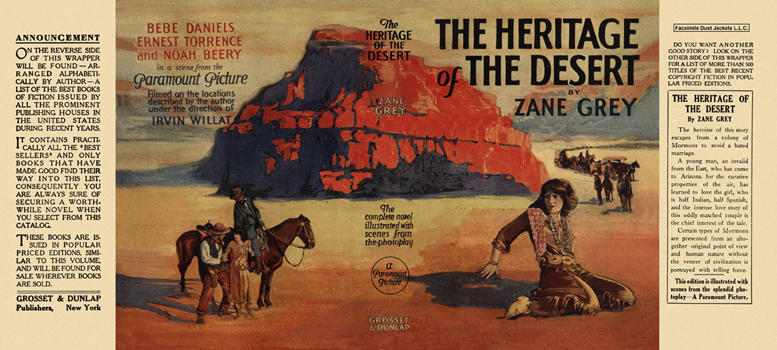Book Review: The Heritage of the Desert by Zane Grey
John “Jack” Hare may be dying, but he can’t stop noticing how beautiful the sky is here in the Utah Territory desert. Jack’s a “lunger,” sent out West for his health. It helped a bit, but his money ran out and he needed a job. He was in Salt Lake City when a cattle outfit in Lund offered him work. He never got to find out what the job was.

In Lund, a bad man named Chance accuses Jack of being a spy sent to catch rustlers, and since Chance works for the notorious rustler Dene, Jack’s life was in danger. Jack was smuggled out the back and told to head for Bane, but he’s walked a full day and night before collapsing, and not come to that town.
And that’s where Jack is found by a wagon train of Mormons. The religious folk debate what to do with him; Jack is clearly on his last legs health-wise, and being hunted by Dene’s gang who are visible in the far distance. Mormon rancher August Naab cites the parable of the Good Samaritan and protects Jack with “creative truth” when Dene’s gang arrives.
Out of immediate danger, the Mormons take Jack to White Sage (he’d missed Bane entirely) for basic medical care. Then August Naab gives Jack the choice to come to his own ranch over in the Arizona Territory for a chance to work and heal. Jack is little aware of what lies ahead, but he will have the chance to earn the heritage of the desert.
This 1910 novel was an early work by Zane Grey (1872-1939), whose career as a writer of Westerns was about to really take off. His descriptions of locations and weather were based on his trips out to the Grand Canyon area.
Once out at August Naab’s extensive spread, Jack is assigned to a high pasture to help August’s beautiful ward Mescal (daughter of a nameless Spaniard and a Navajo woman) tend the sheep. The hard work and healthful atmosphere bring Jack into full remission of his lung condition. He also becomes the rider of the formerly wild stallion Silvermane, most excellent of horses.
Jack realizes that he’s fallen in love with Mescal, and she reciprocates. Unfortunately, she is promised to Snap Naab, August’s eldest son, as his second wife. The one thing that’s kept that marriage from being formalized is the objections of Snap’s first wife.
When the sheep are being herded off the butte, it is discovered that the local water hole has been filled in, and tragedy ensues. This starts the more plot-heavy second half of the novel, as August Naab, his sons, and allies like Jack must do battle of one sort or another against a greedy rancher who wants to control all the water rights.
Good: Zane Grey loves him some landscape description, and his lush language makes the desert and surrounding territory its own character. (Mind, some readers may find the prose a bit purple.) Another thing that I liked but some readers may be bored by is that the story takes its own sweet time; this isn’t one of those breakneck speed Westerns.
The depiction of Mormons and Navajo is pretty even-handed for the literature of the time. There are good Mormons (though August tends to the spirit of the Mormon law rather than the letter), less good Mormons who care more about their own hides than doing the right thing, and bad Mormons. Polygamy is pretty much uniformly treated as a bad thing though. The Navajo are less explored, but have both good and bad points.
There’s a nice assortment of antagonists. Holderness is a large-scale enemy of all the independent ranchers and commands a strong array of underlings. Dene and his gang are a more direct threat on a smaller scale, and Snap Naab is a personal enemy to Jack and Mescal (and his own wife)because of his jealousy and hot temper fueled by alcohol abuse. The odds are somewhat whittled down by evil devouring itself.
Jack grows both as a physical character and as a person during the course of the novel, demonstrating this at the end by showing mercy to those who have sinned, but also demonstrated limits to their evil.
Silvermane is awesome, even getting to dispose of one of the villains personally.
A mute character is treated relatively sympathetically by the characters and story.
Less good: Mescal is the only female character who has more than surface characterization and a life outside her relationship to men. Snap’s long-suffering wife doesn’t even get dialogue or a name!
Content notes: domestic abuse, a little period racism, more than one character intends to rape Mescal (though that word is never used), and I’m going to consider closing a water hole deliberately to make animals die of thirst a form of animal abuse.
Overall: A mighty fine Western, though not Zane Grey’s best work as he was still refining his craft. It’s in the public domain, so you should be able to find a legal download if not one of the many reprints.
This plot was turned into a movie three times, the best of which is reputed to be the 1932 version with Randolph Scott, also known as “When the West Was Young.” Here’s a video!

